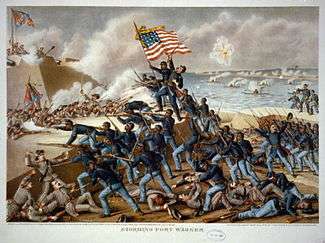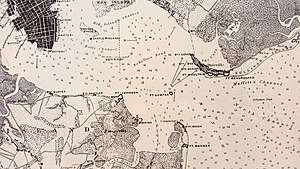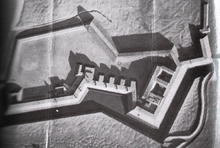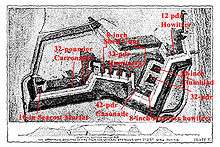Fort Wagner
Fort Wagner or Battery Wagner was a beachhead fortification on Morris Island, South Carolina, that covered the southern approach to Charleston Harbor. It was the site of two American Civil War battles in the campaign known as Operations Against the Defenses of Charleston in 1863, and it is considered one of the toughest beachhead defenses constructed by the Confederate Army.


Construction
Named for deceased Lt. Col. Thomas M. Wagner, Fort Wagner measured 250 by 100 yards (91 m), and spanned an area between the Atlantic on the east and an impassable swamp on the west. Its walls, composed of sand and earth, rose 30 feet (9.1 m) above the level beach and were supported by palmetto logs and sandbags. The fort's arsenal included fourteen cannons, the largest a 10-inch (250 mm) Columbiad that fired a 128-pound shell. It was a large structure capable of sheltering nearly 1,000 of the fort's 1,700-man garrison and provided substantial protection against naval shelling. The fort's land face was protected by a water-filled trench, 10 feet (3.0 m) wide and 5 feet (1.5 m) deep, surrounded by buried land mines and sharpened palmetto stakes.[1] The fort itself was supported by defenses throughout Morris Island.[2]
History


The First Battle of Fort Wagner, occurred on July 11, 1863. Only 12 Confederate soldiers were killed, as opposed to 339 losses for the U.S. side.[1]
The Second Battle of Fort Wagner, a week later, is better known. It was the Union attack on July 18, 1863, led by the 54th Massachusetts Volunteer Infantry, one of the first major American military units made up of black soldiers. Colonel Robert Gould Shaw led the 54th Massachusetts on foot while they charged, and was killed in the assault.[1]
Although a tactical defeat, the publicity of the battle of Fort Wagner led to further action for black U.S. troops in the Civil War, and it spurred additional recruitment that gave the Union Army a further numerical advantage in troops over the South.[1]
Union forces besieged the fort after the unsuccessful assault. By August 25, Union entrenchments were close enough to attempt an assault on the Advanced Rifle Pits, 240 yards in front of the Battery, but the attempt was defeated. A second attempt, by the 24th Massachusetts Infantry, on August 26 was successful. After enduring almost 60 days of heavy U.S. shelling, the Confederates abandoned it on the night of September 6–7, 1863. withdrawing all operable cannons and the garrison.[1][3]
The main reason the fort was abandoned was a concern about the loss of the garrison due to artillery fire and the threat of imminent assault. On September 6, the garrison commander, Colonel Keitt, wrote to his superiors, "The garrison must be taken away immediately after dark, or it will be destroyed or captured. It is idle to deny that the heavy Parrott shells have breached the walls and are knocking away the bomb-proofs. Pray have boats immediately after dark at Cummings Point to take away the men. I say deliberately that this must be done or the garrison will be sacrificed. I am sending the wounded and sick now to Cummings Point, and will continue to do so, if possible, until all are gone. I have a number of them now there. I have not in the garrison 400 effective men, including artillery. The engineers agree in opinion with me, or, rather, shape my opinion. I shall say no more." A council of war in Charleston on the 4th had already reached the same conclusion, and the evacuation was carried out as planned.[4]
After the war a "Lost Cause" revisionist story arose concerning access to fresh water. The claim was made that bodies of the Union troops (54th Massachusetts and many white troops) were buried close to the fort and the decomposition of the bodies poisoned the fresh water well within the fort. Continuing bombardment and interception of food/water supplies by boat from Charleston made holding the fort difficult.[3] This version of the story is directly contradicted by official Confederate correspondence at the time of the evacuation.
Within twenty years of the Civil War, the remnants of the fort had been washed away by erosion on Morris Island. A group of three ex-servicemen traveled to the fort in May 1885 and reported that the entire fort and approaches to it had washed away into the ocean.[5]
The fall of Battery Wagner would have considerable strategic significance. With its loss and that of Fort Gregg, Morris Island too fell to the United States. Although Charleston remained in the hands of the rebels its port was effectively closed. At the end of the year Secretary of the Navy Gideon Welles could report that "the commerce of Charleston has ceased."[6] The impact also showed directly in rebel customs receipts, which fell drastically from 1863 to 1864.[7] The labors and sacrifices of the United States forces during the storms and siege had in the end shut down a vital lifeline to the rebellion.
54th Massachusetts
The most famous regiment that fought for the Union in the battle of Fort Wagner was the 54th regiment, which was one of the first African-American regiments in the war. The 54th was controversial in the North, where many people supported the abolition of slavery but still treated African Americans as lesser or inferior to whites. Though some claimed blacks could not fight as well as whites, the actions of the 54th Massachusetts demonstrated once again the fallacy in that argument, as this was not the first time blacks ever fought in war or even for the United States.
William Carney, an African American and a sergeant with the 54th, is considered the first black recipient of the Medal of Honor for his actions at Fort Wagner in recovering and returning the unit's American flag to Union lines.[1] After the battle, the Confederates buried the regiment's commanding officer, Colonel Shaw, in an unmarked mass grave with the African-American soldiers of his regiment as an insult to him. Instead, his family considered it an honor to bury Shaw with his men.
Morris Island is smaller than 1,000 acres and is subject to extensive erosion by storm and sea. Much of the previous site of Fort Wagner has been eroded away, including the place where the Union soldiers had been buried. However, by the time that happened, the soldiers' remains were no longer there because soon after the end of the Civil War, the Army disinterred and reburied all the remains, including presumably those of Shaw, at the Beaufort National Cemetery in Beaufort, South Carolina, where their gravestones were marked as "unknown."[8]
In popular culture
- This fort plays a major part in the film Glory. One of the final scenes portrays Shaw and the men of the 54th Massachusetts leading the attack and storming the fort unsuccessfully.[1]
A fictional character (in the book "Magnus Chase and the Ship of the Dead") by the name T.J. died charging the battlements at Fort Wagner, South Carolina.
Preservation
Although the Atlantic Ocean consumed Fort Wagner in the late 1800s and the original site is now offshore, the Civil War Trust (a division of the American Battlefield Trust) and its partners have acquired and preserved 118 acres (0.48 km2) of historic Morris Island, which had gun emplacements and other military installations during the war.[9]
References
- The 54th and Fort Wagner Archived 2007-09-30 at the Wayback Machine
- Correspondence relating to fortification of Morris Island and operations of engineers. New York. 1878. Retrieved 26 September 2014.
- Twiggs, T. D. D., Hon. Lieut. Col. (CSA, retired, deceased), The Defense of Battery Wagner North & South - The Official Magazine of the Civil War Society, Issue 4, Page 46.
- "The War of the Rebellion", Series I, Volume 28, part I, pp. 100-105 http://ebooks.library.cornell.edu/cgi/t/text/pageviewer-idx?c=moawar;cc=moawar;q1=evacuated;rgn=full%20text;idno=waro0046;didno=waro0046;view=image;seq=120;page=root;size=100 See also http://civilwardailygazette.com/confederates-abandon-battery-wagner/
- "Battery Wagner Swept Away". Charleston News & Courier. May 9, 1885. p. 8. Retrieved Nov 12, 2012.
- "New York Times" December 1o, 1863, "Report of Secretary Welles" https://www.nytimes.com/1863/12/10/news/navy-department-report-secretary-welles-north-atlantic-squadron-south-atlantic.html?pagewanted=all
- "Confederate Finance" Richard Cecil Todd, University of Georgia Press, 1954, p. 125
- Buescher, John (2010-08-08). "Robert Gould Shaw". Teachinghistory.org. Retrieved 2017-10-08.
- American Battlefield Trust "Saved Land" webpage. Accessed May 24, 2018.